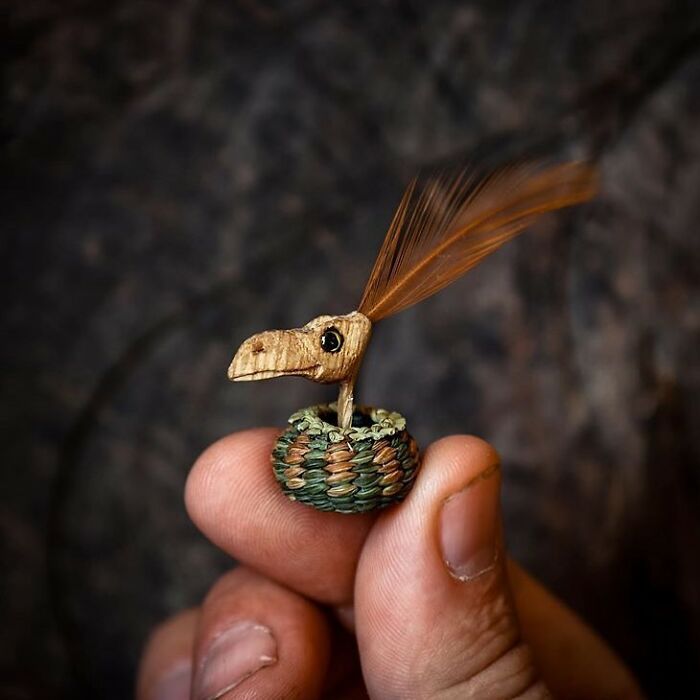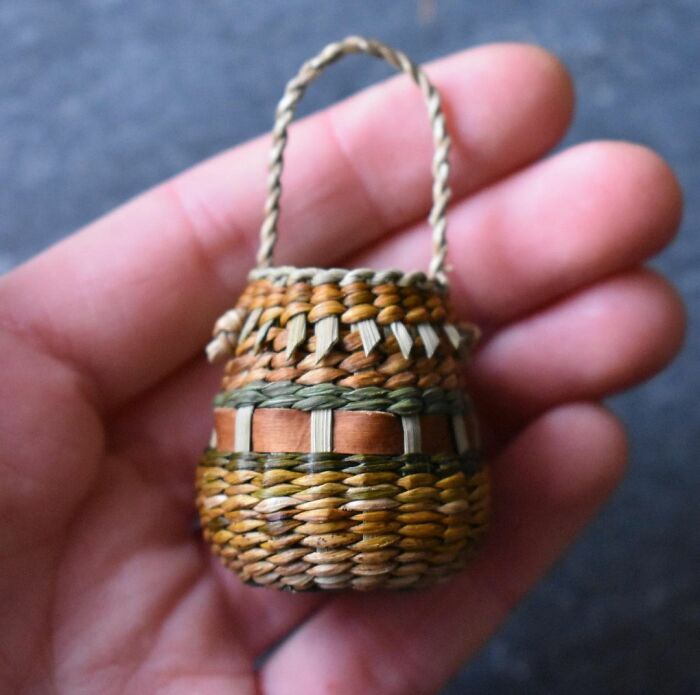
Self-Taught Artist Transforms Leaves And Weeds Into 30 Mini Hand-Woven Baskets
Interview With ArtistWhile most see plants as a key part of nature—one that makes sure humanity doesn’t run out of air, provides food, and makes the world more beautiful—there’s more than meets the eye.
Meet Suzie Grieve of Foraged Fibres, a wild basket and jewelry maker from Lake District, UK who weaves miniature baskets as well as tiny jewelry using leaves, vines, and weeds.
Check out some of her best works in our curated list below. And, hey, while you’re there, leave a comment and an upvote on the ones you like the most!
More Info: Instagram | Website
This post may include affiliate links.
The artist, Suzie Grieve, can make a whole set of these as toys for kids as a business. This can be included with a book/pamphlet to show eco-friendly ways to use materials and sustainable way of living. Children will get to learn early. Just a suggestion. Amazing stuff.
As mentioned above, Suzie Grieve, the mastermind behind Foraged Fibres, is a self-taught wild basket and jewelry maker from Lake District, a region and national park in Cumbria in northwest England.
Grieve weaves miniature baskets and tiny jewelry using dried leaves, vines, and weeds. She also weaves regular-sized baskets, if you’re wondering.
Bored Panda got in touch with Suzie for an interview, so continue scrolling to read more!
It took a long time, and a visit to her website, but I finally decided this is my favourite photo...
“The first time I wove anything was whilst I was living in a community in central France. It was my job to create vegetable beds so I used the abundantly growing hazel to weave the edges,” Grieve explained the origins of her endeavor.
“Whilst weaving the sticks in place, I felt an immediate connection to the craft, the simple meditative rhythm of the weaving, the beautiful tactile way in which it allows you to connect with the land and the feeling of self reliance. To be able to create with only your hands and what's growing around you is an amazing feeling.”
Now, where Grieve lives, it is a bit of a challenge to find the right material for crafting these beautiful baskets and pieces of jewelry, but she found a way around it:
“Since moving back to the Lake District, I've had to adapt the way I find and gather the plants I use in my work. There is a real lack of wild space here to freely harvest materials from, which has forced me to make some beautiful connections with local landowners over the years who allow me to gather from their woodlands and fields in exchange for some simple work such as chopping wood,” explained Grieve.
The plants she gathers, obviously, depend on the seasons, which she particularly enjoys because of the awareness of the seasons and their cycles that it all provides.
She told Bored Panda that, in springtime, she gathers willow bark and dandelions. In the summer, it’s the likes of nettles and brambles. Autumn is “a mad rush of harvesting long leafy things,” while in the winter—as much as the short daytime allows—she forages vines, such as honeysuckles and ivy.
all of these baskets are amazing and lovely. good eyes and tiny hands? really cool
As you might have figured, the whole process isn’t as clear-cut as one might think, requiring time, effort, and, needless to say, luck finding the needed plants. And this is besides all of the processes in between.
“It's a crazy lengthy process using wild-crafted materials for weaving. There's the hours spent finding the plants, gathering and processing them and hanging them up to dry before you even come to rehydrating them for weaving, but I love it. I'm quite an introvert and between wandering in the forests looking for leaves and hermitting away in my weaving workshop, it suits me perfectly. I've always been obsessed with plants, so I'm super grateful I get to spend my days tangling them into little baskets.”
“To make sure I gather as sustainably as possible, I started to experiment weaving with the so-called 'weeds' and invasive plants that grow abundantly and locally. I've discovered that these are often amazingly strong and flexible plants as they must be to survive—it's in their nature,” explained Grieve.
“A few of my favorite plants to weave with are dandelion, bramble and bindweed. The beauty of using these plants is that they often get removed, mowed or pruned anyway. May as well turn them into a basket instead of going to waste.”
“Being reliant on nature like this also gives you such a deep respect and desire to care for the environment around you, it's not within a forager’s interest to ever overharvest or damage the population of a plant.”
“One of the simple reasons I work in miniature, creating tiny baskets and woven necklaces, is the lack of space to grow or store massive amounts of materials, the tiniest of my baskets often being woven from a single leaf. Mostly, though, it's just my unexplainable love for miniatures, especially miniature crafts.”
“I have to admit I have a slightly obsessive nature and until I make the world's smallest basket, I shall keep on weaving up tiny vessels! Currently my priority is getting my book on wild basketry together so weaving has taken a little bit of a back step until I get that finished!”
How amazing! Her lifestyle and philosophy are almost druid-like and I love that.
How amazing! Her lifestyle and philosophy are almost druid-like and I love that.

 Dark Mode
Dark Mode 

 No fees, cancel anytime
No fees, cancel anytime 






































































































